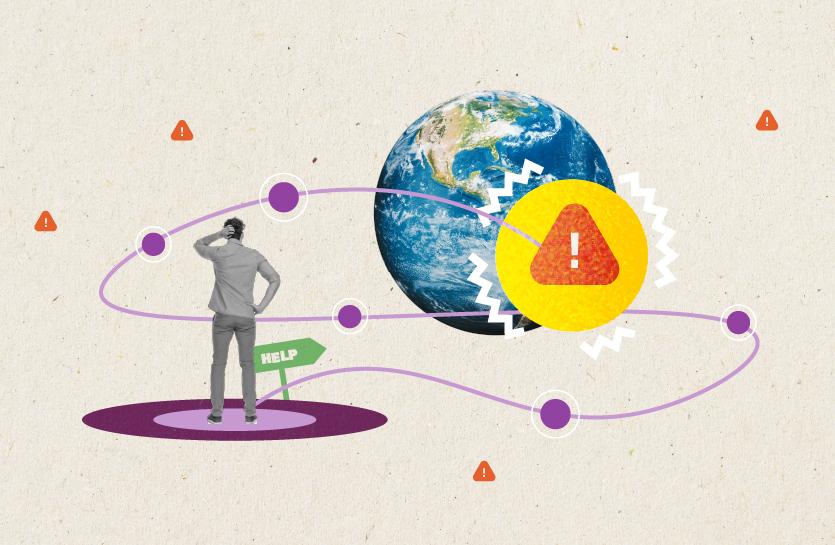3 Ways to Lend Your Support After a Natural Disaster
September 16, 2022
5 min read
Updated on January 12, 2024
When a natural disaster strikes, many feel called to help but simply don’t know where to start.
In recent years record-breaking heatwaves and historic floods have hit Canadian communities hard, and the global stage isn’t any less dramatic. Unprecedented droughts, wildfires, hurricanes, famine and floods continue to make headlines worldwide.
Watching these natural disasters unfold from afar can leave many of us feeling helpless. The truth is our interconnectedness is more valuable now than ever before. Your generosity can make a difference, and a strategic, empathetic, and well-informed approach will help your giving go further.
These three principles, backed by the expert insights of Catheryne Gagnon, Bilingual Press Officer at Médecins sans frontières/Doctors Without Borders (MSF), can guide charitable Canadians toward providing strategic, impactful, and long-term support.
1. Pinpoint the hardest-hit communities
Start by researching and identifying trusted charities that are embedded in affected communities and support those best equipped for a quick response. Diverse local conditions, infrastructure, and cultures create a need for tailored approaches rather than one-size-fits-all solutions.
“When natural disasters occur, the best responses are those that are driven first and foremost by the needs of the communities most affected,” said Gagnon.
“From an individual perspective when wanting to help, a great way to start is by doing research. Identify trusted organizations to donate to who are most equipped to implement a quick and flexible response because they are established in these communities and have existing structures and resources to assess and respond to urgent needs,” said Gagnon.
2. Think long-term
More consistent long-term funding can help charities across the sector plan ahead for annual programs. In disaster responses, sustained giving can also ensure urgent humanitarian needs dictate funding amounts rather than resource limitations.
“When thinking about giving, one of the best ways to support humanitarian organizations is to contribute via regular (e.g., monthly or annual) general donations, not tied to a specific emergency or context. This allows organizations to monitor needs and to be more flexible and reactive by drawing from these general emergency funds when resources are needed to act,” said Gagnon.
3. Get acquainted with the disaster response cycles
Mitigation
A major, far-reaching effort crosses into areas of public policy and infrastructure planning. This phase reduces the likelihood of a future disaster—or, if inevitable, lowers its impact.
Preparation
The preparation phase helps individuals and communities respond to potential natural disasters. Establishing volunteer response organizations, early warning systems, and evacuation plans can prepare people for rapid-onset natural disasters such as floods or wildfires.
Response
The United Nations Office for Disaster Risk Reduction (UNDRR) defines response as “actions taken directly before, during or immediately after a disaster to save lives, reduce health impacts, ensure public safety, and meet the basic subsistence needs of the people affected.”
This urgent and immediate phase involves frontline emergency responders, such as firefighters, medics, volunteers, organizers overseeing evacuations, therapists providing mental and emotional support, charities providing resources—the list goes on.
Recovery
Recovery is the long, slow process of rebuilding what a disaster has destroyed, involving restoring or even improving livelihoods and health. Following the movement of the cycle, recovery efforts may cross over into the mitigation phase, such as securing improvements in infrastructure to withstand floods or fires.
“Recovery can be a complex process, especially in massive humanitarian emergencies with often disastrous consequences for people,” said Gagnon. “Emergencies may disrupt or decimate healthcare systems and infrastructures and can lead to entire communities being uprooted and displaced.”
There is overlap between these phases, and underlying inequities can exacerbate needs. “Natural disasters disproportionately impact communities already affected by other crises such as conflicts, climate degradation and epidemics, and these crises are often linked,” said Gagnon.
Set your strategy in motion
- Create a shortlist. Your research begins by creating a list of charities that align with your values. Once you’ve identified some organizations or programs that resonate with you, take the initiative to reach out.
- Ask questions. Don’t shy away from asking charities direct questions about how your contributions will be utilized. Understanding the specifics of your impact is not just empowering; it’s key to fulfillment and longevity in your giving journey.
